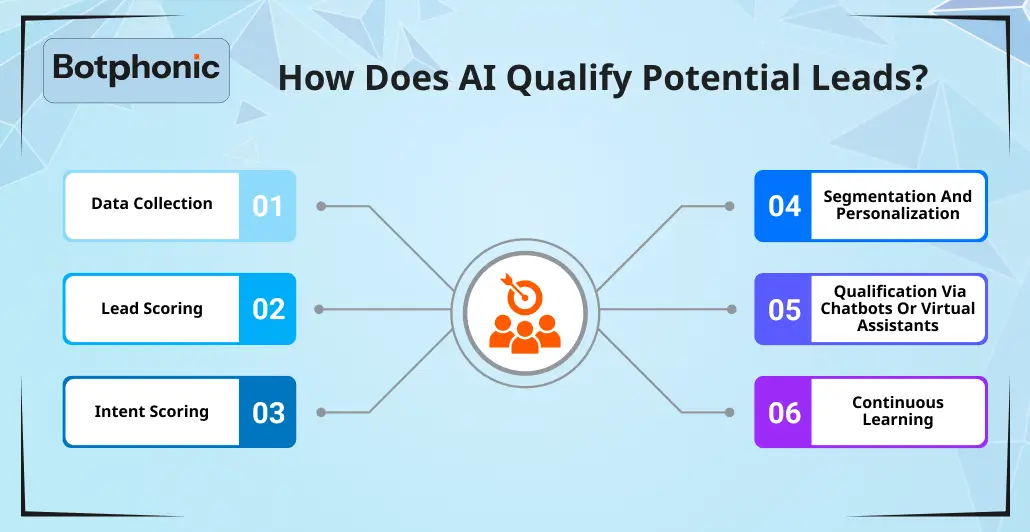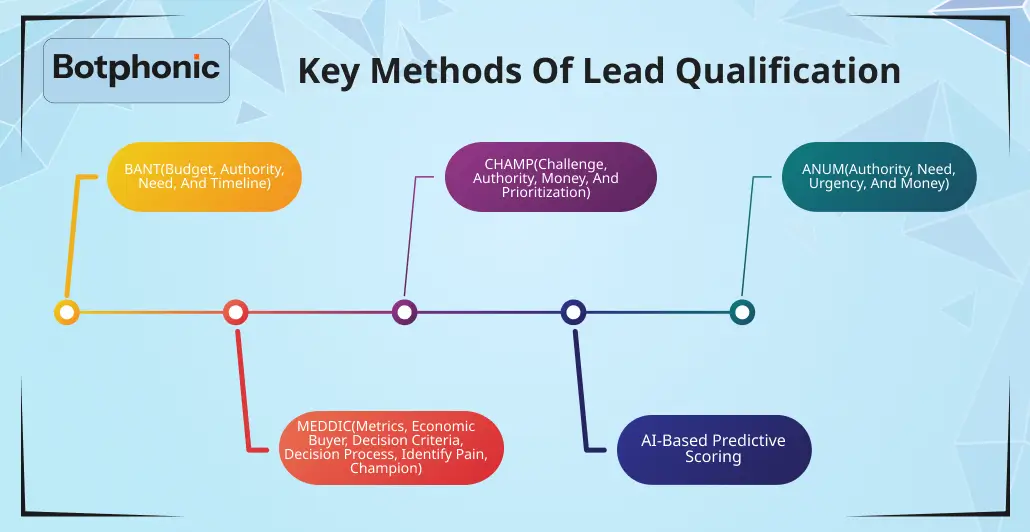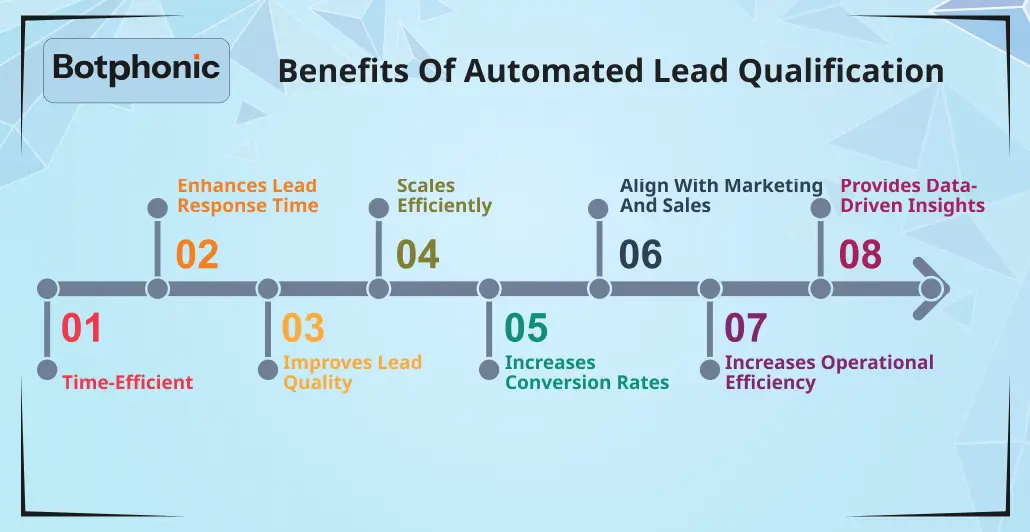
Summarize Content With:
Quick Summary
Lead qualification is a process of preparing sales and helping businesses to create their potential and loyal customer base. It helps them organize, identify, and place the leads in the right order. In this blog, we are going to learn how automating lead qualification helps in automating customer relationship management itself.
Introduction
In this evolving world of technology, businesses are turning their manual work to streamline operations, with the help of AI business process automation tools to AI call assistant, which helps them grow their business and customer base more efficiently than before. From automated customer relationship management to using AI in managing workflow automation for small businesses, they are all working in this new era in their own unique way.
And we are introducing you to a new way to create your own quality customer base with automated lead qualification. It is a crucial process of maintaining modern sales and helping organizations to create business.
What is Automated Lead Qualification?
Automated Lead qualification is the process of monitoring, evaluating, and getting to know your potential customers using artificial technology and automation, these customers are known as leads, which help determine the level of becoming their client. This method helps businesses grade their sales effort by focusing on potential customers who are really into their business rather than who are less interested. It helps evaluate effectively and reduce manual workload, while increasing productivity and reducing cost.
Types of Leads
In sales and marketing, leads are the suitable and most potential customers who are willing to make a purchase and have shown interest in the product or service. These are often categorized by their level of interest, engagement and how interested they are into becoming a paying customer. Here we are going to see the main types of leads in which customers are categorized.
1. Cold Leads
These refer to people or the company who haven’t shown their interest yet or didn’t even have any kind of interaction with your brand. For example you have received the list of contact numbers and emails from a purchased database. You can always ignite their interest with a warm outreach using content marketing or business automation platforms that help you connect easily.
2. Warm Leads
Warm leads are identified as people have shown little interest and have done engagement with your ad or by visiting your website. For example, it can be someone who was going through IG reels but have seen your ad and they have clicked on CTA to know more about it. You can always bring them towards sale with a targeted source of content which piques their interest.
3. Hot Leads
These are people who are into your product and there are high chances of them making a purchasing decision. For example they have requested a pricing quote or demo of your service. You should take the proper follow-up with personalized chat to close the deal timely.
4. Information Qualified Leads
It is referred to as people who are at the top-of-funnel and looking for more information, might be solve a problem or they are just into it. They are exchanging information for something valuable in return, such as registering themselves for a newsletter or downloading an ebook. They are at an awareness stage, which can be used to provide educational content.
5. Marketing Qualified Leads
Marketing qualified leads are people who have qualified the criteria after engaging with your marketing efforts and have shown potential interest in buying, for example they have frequent website visits and opened multiple emails from you. You can also use BPM automation tools to reduce manual work.
6. Sales Qualified Leads
These are the leads which are identified by marketing teams and are directed to the sales team for direct contact. For example, customers might have requested a demo and it also meets their budget and other criteria. They are at the decision making stage, you can map out their interest by using a business automation tool and identify their needs.
How Does AI Qualify Potential Leads?
AI helps qualify prospective leads by analyzing the large volumes of data, which helps them identify potential people who are most likely to turn into customers. It is usually done by using predictive analytics or AI business process automation. Let’s read more about how AI helps you qualify leads:

1. Data Collection
AI first collects the data from multiple sources that you might have provided, such as from CRM systems like salesforce, HubSpot, or website activity of the user for example page visits, and time spent on website, email engagements, or even social media interactions.
2. Lead Scoring
AI uses predictive lead scoring to arrange the leads based on the possibilities of their conversion. Machine learning and process automation software can be used to analyze historical data from previous successful leads to find patterns. Scoring criteria might include behaviour, engagement and fit, after which each lead gets a score or categorized into types such as hot, warm, cold, etc.
3. Intent Scoring
AI helps you identify the purchase intent of customers by analyzing keywords used in emails or chats, content downloaded by them such as if it’s case study they have higher intent of buying. And most crucial is timing, if there’s repeated visits it means they have urgency and are most likely to buy.
4. Segmentation and Personalization
AI helps you make a group based on characteristics and behaviour of the user. For example, if it’s industry or role based segments, or they are in the funnel stage. It then helps personalize the follow-up content or messaging for each segment, such as chatbots, AI virtual assistants, or even sales scripts.
5. Qualification via Chatbots or Virtual Assistants
AI-powered chatbots can interact with leads in real-time. They can help you by asking meaningful and direct questions like “What’s your budget?”, “Are you the decision-maker?”, and similar questions which are leading to sales, it will help you qualify leads 24/7, you can use business process automation software to deal with it, which will help you quickly pass SQLs to sales agents.
6. Continuous Learning
Just like human beings, AI also continues to learn but at a faster pace, the more data AI processes, the better it gets. It helps refine scoring models, identifies new behavior patterns and updates the regular customer profiles timely.
These steps help AI qualify potential leads leading to a successful conversion rate.
Key Methods of Lead Qualification
WIth the types of lead, you should never think there’s just a single way to qualify a prospective lead, if you are treating them equally, you might have been wasting time, energy, and resources. And that’s where automated lead qualification will help you. We are going to explore the most widely known and effective lead qualification frameworks, from classic models like BANT and CHAMP to advanced AI-driven strategies.

1. BANT(Budget, Authority, Need, and Timeline)
It is one of the most widely used framework, it elaborates on user or lead’s most important aspects, which are:
- Budget: If lead can really afford the product or service offered?
- Authority: Is the decision making in the leader’s responsibility or they are substitutes?
- Need: Does our lead need this product? If our product is what can solve their problem?
- Timeline: And last but not the least, when are they expecting to purchase?
These methods are usually best for B2B sales where deals are large and decision making periods are long.
2. CHAMP(Challenge, Authority, Money, and Prioritization)
This method is considered as a modern alternative to BANT, with more customer focus. It focuses on pain points, economy, and priority of customer’s needs.
- Challenge: It puts more emphasis on what are the pain points that the customer is trying to solve by making a purchase from them?
- Authority: Similar to BANT, it also focuses on if the lead is responsible for purchasing or they are just asking as a substitute?
- Money: If their product fits the customer’s budget and vice versa.
- Prioritization: Do they have an immediate requirement of the product or is it somewhere lower on their priority list.
It is best for solution selling and customer-centric sales teams who are focused on creating a purchase from the buyer.
3. ANUM(Authority, Need, Urgency, and Money)
This method puts more emphasis on decision-maker rather than focusing on sales first:
- Authority: Are you co-ordinating with the correct person?
- Need: If they are really looking for the product in question?
- Urgency: How fast are they willing to purchase the product?
- Money: Can they afford your solution or is there any dilemma?
This method is best for fast-paced or transactional sales cycle, who are looking for quick purchase.
4. MEDDIC(Metrics, Economic Buyer, Decision Criteria, Decision Process, Identify Pain, Champion)
It is a detailed, data-driven approach which is usually used by enterprise sales. This process is followed by the data provided by the user and predictive analysis to determine buyer’s intent.
- Metric: It puts emphasis on what is the quantifiable value of your product and how is it measured?
- Economic Buyer: Who is responsible for putting their money for the solution?
- Decision Criteria: It discusses what are the factors that influence their choice of buying?
- Decision Process: What steps are the crucial factors they follow while buying?
- Identify Pain: What are the problems they are facing, that’s making them purchase your product, and your product justifies as a solution?
- Champion: If there’s anyone in buyer’s group who is in favour of your product and can advocate it
This method is complex and is usually used by high ticket B2B sales. To implement it successfully one can use enterprise process automation.
5. AI-Based Predictive Scoring
This method uses data and machine learning on another level to score leads based on their:
- Past Behaviours: It explains how they have shown themselves to the company such as their clicks, and downloads.
- Demographics or Firmographics: What are they more drawn to?
- Engagement Level: How much time they have spent on the website and which product are they drawn to?
- Fit with Ideal Customer Profile(ICP): If they are checking all the criterias of potential buyer for the same.
For doing the appropriate analysis of past behaviors one can use contact center automation data and for scoring BPM business management process software can be accessed.
How To Do Automated Lead Qualification?
Automated lead qualification uses technology, especially AI by incorporating automated business workflow and customer support automation tools, CRM tools to identify, assess, and arrange leads in priority order without any human interaction.
Here’s a proper guide on how you can automate lead qualification:
1. Create Your Ideal Customer Profile:
Before deciding on automation, predefine what your “qualified lead” is, you should focus on a few aspects such as, industry, company size, job title, budget range, pain points, and purchase intent of the buyer. These factors will help you create a perfect buyer persona.
2. Use Lead Capture Forms
Create forms that can be used to gather data and key information automatically from the user and add fields that can help determine your potential lead. You can include fields such as company name, job title, budget, and timeline.
3. Implement AI-Powered Lead Scoring
You can use AI driven customer service automation platforms or machine learning models to score leads based on their website behavior, demographic fit, email engagement, social media interaction, and even past buying signals.
4. Deploy Chatbots or Virtual Assistants
Ensure to use quality chatbots and virtual assistants with a process automation platform which can help you qualify leads in real time by asking direct and meaningful questions related to purchase such as “what’s your challenge right now”, “what’s your budget”, and many more related questions. They can route qualified leads to sales agents instantly increasing the conversion rate.
5. Automate Segmentation and Workflows
Once leads are analyzed and scored, you can use marketing automation to:
- Categorize them in hot, warm, or cold categories
- Start personalized email campaigns.
- Assign the responsible sales agent based on lead value.
You can use business automation services to improve your work efficiency and lead qualification rate.
6. Integrate with CRM and Business Process Automation Platforms
You can connect and collect all lead sources such as websites, ads, emails, and social media to your CRM. Use business process automation platforms or software to sync the data and prioritize the leads after streamlining lead qualification tasks.
7. Monitor, Analyze, and Modify
After completing scoring and automation, review AI scores and actual conversions to compare the results from before and after automation. Adjust your scoring model and ICP regularly based on feedback and scores.
Benefits Of Automated Lead Qualification
Automated lead qualification offers remarkable benefits if compared to manual lead qualification. By automating repetitive and hassle creating tasks, organizations can reduce costs and increase their overall sales performance.

1. Time-Efficient
By automatically qualifying potential leads it helps filter out unqualified leads and agents can focus on high priority tasks instead of manually reviewing each inquiry.
2. Enhances Lead Response Time
After using AI chatbots and automation of customer service, it helps engage leads instantly 24/7 without getting interrupted and overwhelmed. Hot leads are instantly routed to a responsible agent. With faster follow-up,it increases higher conversion rates.
3. Improves Lead Quality
AI uses consistent criteria to qualify leads such as asking questions after building an ICP. It can help you reduce the chances of human error and opinionated judgement.
4. Scales Efficiently
Using automatic call center software for lead qualification, it helps handle thousands of leads without additional headcount. It is suitable for growing businesses and high-traffic campaigns. It leads to productivity without burning out the team.
5. Increases Conversion Rates
AI helps prioritize leads which are most likely to convert based on their behavior and data collected through sources. It helps you create a personalized follow-up path at the right time.
6. Align with Marketing and Sales
With shared data and automated workflows it reduces the chances of eros and helps lead scoring and segmentation as a clear process.
7. Increases Operational Efficiency
While integrating with business process automation softwares to create a smooth workflow, AI helps trigger actions automatically such as email, follow-up, CRM updates and task assignments.
8. Provides Data-driven Insights
Using automation helps track lead behaviour, score accuracy and analyze the conversion trends effectively. It helps refine targeting and qualification models with time. It helps make continuous improvement and leads to smarter decision-making.
Conclusion
In this generation of fine technology and AI-driven workflow management, the competition is increasing, by integrating AI-driven tools and business workflow automation companies can streamline their sales funnel, reduce head-counts and can be more time-efficient. Automated lead qualification is more than just a tool, it has become a strategic necessity to grow exponentially.
While incorporating intelligent chatbots, AI-powered lead scoring and evaluation organizations can become more reliable and scalable.

